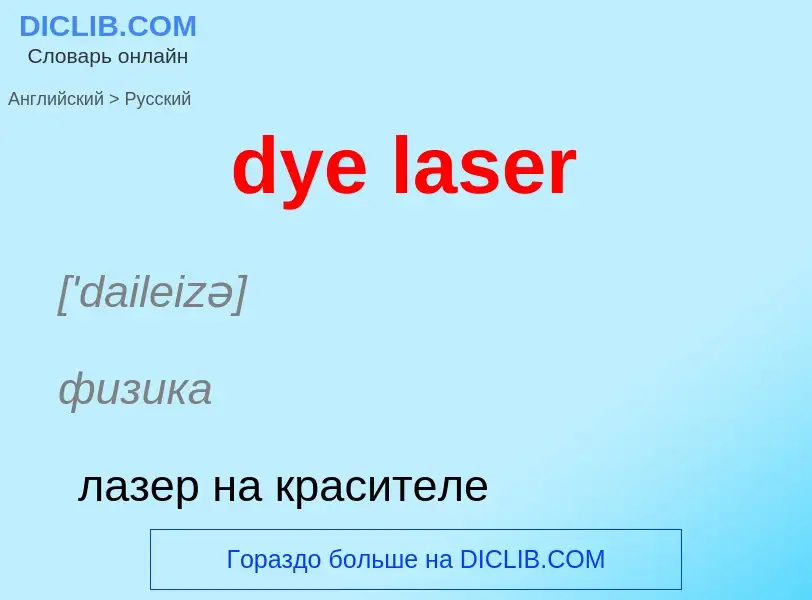Vertaling en analyse van woorden door kunstmatige intelligentie ChatGPT
Op deze pagina kunt u een gedetailleerde analyse krijgen van een woord of zin, geproduceerd met behulp van de beste kunstmatige intelligentietechnologie tot nu toe:
- hoe het woord wordt gebruikt
- gebruiksfrequentie
- het wordt vaker gebruikt in mondelinge of schriftelijke toespraken
- opties voor woordvertaling
- Gebruiksvoorbeelden (meerdere zinnen met vertaling)
- etymologie
dye laser - vertaling naar russisch
['daileizə]
физика
лазер на красителе
лазер на органических соединениях
[dai]
общая лексика
краситель
красящее вещество
красить
окрашивать
подкрашивать
краска
красящий
нефтегазовая промышленность
сигнальная цветная присадка к бензину
красить, подкрашивать
Смотрите также
существительное
[dai]
общая лексика
краска
краситель
красящее вещество
окраска
цвет
глагол
общая лексика
(dyed ‹-{dai}d›) красить
окрашивать
окрашиваться
краситься
принимать краску
красить, окрашивать
принимать краску, окрашиваться
синоним
Definitie
Wikipedia

A dye laser is a laser that uses an organic dye as the lasing medium, usually as a liquid solution. Compared to gases and most solid state lasing media, a dye can usually be used for a much wider range of wavelengths, often spanning 50 to 100 nanometers or more. The wide bandwidth makes them particularly suitable for tunable lasers and pulsed lasers. The dye rhodamine 6G, for example, can be tuned from 635 nm (orangish-red) to 560 nm (greenish-yellow), and produce pulses as short as 16 femtoseconds. Moreover, the dye can be replaced by another type in order to generate an even broader range of wavelengths with the same laser, from the near-infrared to the near-ultraviolet, although this usually requires replacing other optical components in the laser as well, such as dielectric mirrors or pump lasers.
Dye lasers were independently discovered by P. P. Sorokin and F. P. Schäfer (and colleagues) in 1966.
In addition to the usual liquid state, dye lasers are also available as solid state dye lasers (SSDL). These SSDL lasers use dye-doped organic matrices as gain medium.


![An [[atomic vapor laser isotope separation]] experiment at LLNL. Green light is from a copper vapor pump laser used to pump a highly tuned dye laser which is producing the orange light. An [[atomic vapor laser isotope separation]] experiment at LLNL. Green light is from a copper vapor pump laser used to pump a highly tuned dye laser which is producing the orange light.](https://commons.wikimedia.org/wiki/Special:FilePath/AVLIS laser.jpg?width=200)
![expand the beam]] in one direction, providing better illumination of a [[diffraction grating]]. Depending on the angle unwanted wavelengths are dispersed, so are used to tune the output of a dye laser, often to a linewidth of a fraction of an [[angstrom]]. expand the beam]] in one direction, providing better illumination of a [[diffraction grating]]. Depending on the angle unwanted wavelengths are dispersed, so are used to tune the output of a dye laser, often to a linewidth of a fraction of an [[angstrom]].](https://commons.wikimedia.org/wiki/Special:FilePath/Dual prism expander and grating reflector for a dye laser.jpg?width=200)


![[[Stokes shift]] in Rhodamine 6G during broadband absorption/emission. In laser operation, the Stokes shift is the difference between the pump wavelength and the output. [[Stokes shift]] in Rhodamine 6G during broadband absorption/emission. In laser operation, the Stokes shift is the difference between the pump wavelength and the output.](https://commons.wikimedia.org/wiki/Special:FilePath/Stokes shift- Rh6G.png?width=200)

